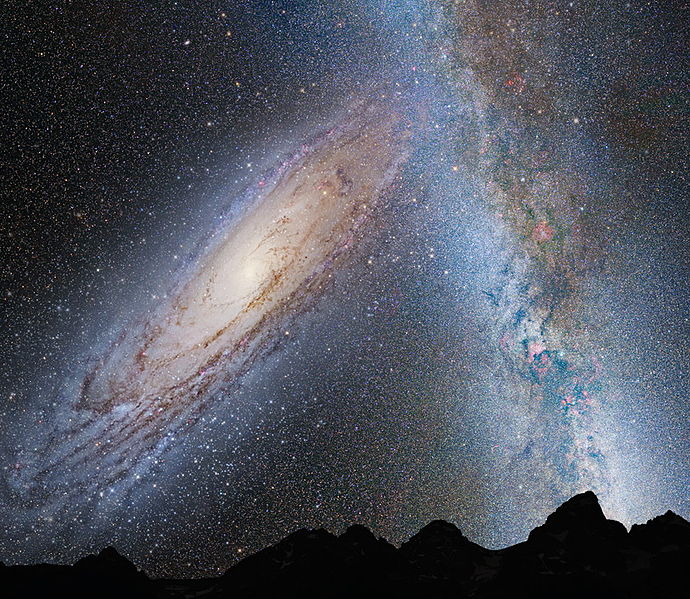Nastanek našega doma Galaksija Milky Way began 12 billion years ago. Since then, it has undergone a sequence of mergers with other galaxies and grew in mass and size. The remnants of building blocks (i.e., galaxies that merged with the Miky Way in the past) can be identified through their unusual values for energy and angular momentum and low metallicity. The two earliest building blocks of our home Galaksija have recently been identified using Gaia dataset and have been named Shiva and Shakti after Hindu deities. Gaia prostor telescope which is dedicated to the study of our home galaxy has revolutionised the study of Milky Way. Gaia Enceladus/ Sausage stream, the Pontus stream and the “poor old heart” of the Milky Way were identified earlier using Gaia dataset. The history of Milky Way is replete with mergers. Hubble Vesolje Telescope images suggest that six billion years from now, our home galaxy will merge with the neighbouring Andromeda galaxy.
Galaksije in druge velike strukture so nastale v Vesolje približno 500 milijonov let po velikem poku.
Nastanek našega doma Galaksija Rimska cesta se je začela pred približno 12 milijardami let. Od takrat je doživela vrsto združitev z drugimi galaksijami, ki so prispevale k rasti njene mase in velikosti. Zgodovina Rimske ceste je v bistvu zgodovina združitve drugih galaksij z našo domačo galaksijo.
The basic properties of the zvezde like energy and angular momentum are directly linked to the speed and direction of the Galaksija of origin and are shared between the stars of the same galaxy. When galaxies merge, energy and angular momentum remain conserved over time. This serves as a key tool in identification of a merger remnant. A large group of zvezde with similar unusual values of energy and angular momentum are likely to be a merger remnant of a galaxy. Also, the older stars have low metallicity, i.e., stars that formed earlier have low metal contents. Based on these two criteria, it is possible to trace merger history of the Milky Way however it would not have been possible without the Gaia datasets.
Launched by ESA on 19 December 2013, Gaia prostor telescope is dedicated to the study of Milky Way including its origin, structure and evolutionary history. Parked in Lissajous orbita around L2 Lagrange point (located approximately 1.5 million km from Earth in the direction opposite the Sun) along JWST and Euclid spacecrafts, Gaia probe is conducting a huge stellar census covering about 1.5 billion stars in the Milky Way recording their motions, luminosity, temperature and composition and creating a precise 3D map of the home Galaksija. Hence, Gaia is also referred as billion-star surveyor. The datasets generated by Gaia has revolutionized study of history Milky Way.
In 2021, using Gaia datasets, astronomers learnt of a major merger and identified Gaia Enceladus/Sausage stream, the remnant of Gaia-Sausage-Enceladus (GSE) Galaksija that merged with the Milky Way between 8 and 11 billion years ago. Subsequently, Pontus stream and “poor old heart” of the Milky Way were identified the following year. The Pontus stream is the remnant of Pontus merger while “poor old heart” is zvezda group that formed during the initial mergers that created the proto-Milky Way and continue to reside in the central region of Milky Way.
Now, astronomers report discovery of two streams of zvezde that formed and merged with an early version of our Milky Way between 12 and 13 billion years ago, around the time when galaxies were forming in the early Vesolje. Za to so raziskovalci združili podatke Gaia s podrobnimi zvezdnimi spektri iz Sloan Digital Survey (DR17) and observed that stars were crowded around two specific combinations of energy and angular momentum for a certain range of low-metal stars. The two groups had angular momentum similar to the stars that had been part of separate galaxies which merged with the Milky Way. Perhaps, the earliest building blocks of the Milky Way, the researchers have named them Shiva and Shakti after the Hindu deities. It is possible that the newly discovered star groups were first to merge with the ‘poor old heart’ of our Milky Way and the story towards a large Galaksija began. Future studies should confirm if Shiva and Shakti are indeed part of prehistory of Milky Way.
Kaj se bo zgodilo z našo domačo galaksijo v prihodnosti?
Evolucijska zgodovina Rimske ceste je polna združitev. Hubble Vesolje Telescope images suggests that six billion years from now, our home galaxy will merge with the neighbouring Andromeda galaxy situated at 2.5 million light-years away to give rise to a new galaxy. Andromeda will collide with the Milky Way at 250,000 mph about 4 billion years from now. The clash between the two galaxies will last for 2 billion years giving rise to a combined elliptical galaxy.
The solar system and the Earth will survive but will have new coordinates in prostor.
***
Reference:
- Naidu RP, sod 2021. Rekonstrukcija zadnje večje združitve Rimske ceste z raziskavo H3. The Astrophysical Journal, letnik 923, številka 1. DOI: https://doi.org/10.3847/1538-4357/ac2d2d
- Malhan K., sod 2022. Globalni dinamični atlas združitev Rimske ceste: Omejitve iz orbit kroglastih kopic, zvezdnih tokov in satelitskih galaksij, ki temeljijo na Gaia EDR3. Objavljeno 17. februarja 2022. The Astrophysical Journal, letnik 926, številka 2. DOI: https://doi.org/10.3847/1538-4357/ac4d2a
- Malhan K. in Rix H.-W., 2024. 'Shiva in Shakti: domnevni protogalaktični fragmenti v notranji Rimski cesti. Astrophysical Journal. Objavljeno 21. marca 2024. DOI: https://doi.org/10.3847/1538-4357/ad1885
- Max Planck Institute for Astronomy (MPIA). Novice – Raziskovalci identificirajo dva najzgodnejša gradnika Mlečne ceste. Na voljo na https://www.mpia.de/news/science/2024-05-shakti-shiva?c=5313826
- Schiavi R. et al 2021. Prihodnja združitev Mlečne ceste z galaksijo Andromeda in usoda njihovih supermasivnih črnih lukenj. Prednatis pri arXiv. DOI: https://doi.org/10.48550/arXiv.2102.10938
***






































